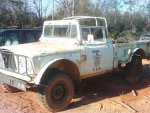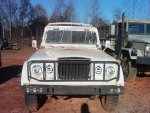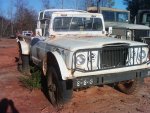Barrman
Well-known member
- 5,266
- 1,782
- 113
- Location
- Giddings, Texas
Before this turns into a bigger arguement. Think of it this way. What was your Unimog designed to do? Does it do that well? When asked to something it wasn't designed to do, does it do that something in a not so great way or not at all?
Every vehicle was design to do something well. The M35 series of trucks was designed around the REO Gold Comet OA 331 gasoline engine. The first real succesfull overhead valve truck industial/commercial use engine. Everything about the truck was made with that engine in mind from the Timken axles (later renamed Rockwell) to the hood size and the mission of the truck. Haul 2-1/2 tons of stuff over non roads and 5 tons of stuff on roads up to 30 mph. Fuel efficiency was probably only considered when deciding how big the fuel tank should be.
10 years later, NATO is now something beyond some State department staffers day dream, having a common supply chain is a real concern for all the forces that might be deployed to fight in the any day now battle going to happen in the Fulda Gap. The Multifuel engine is stuffed into the truck designed for the OA331. The hood had to be raised an inch or so, but it fit otherwise. It is just a happy coincidence that besides the grill gaurd and 4 parts inside the transmission everything else could still work.
Not as good though in some ways. My Gasser M35 will idle along at 400 rpm in 1st low at less than 1 mph without being heard 100 feet away. Unless I run over something. My whistler won't go that slow by about 5 mph and if the wind is right can probably be heard a mile away. My Gasser will out run the Whistler on flat ground by about 15 mph top speed. But it will only go half as far as my whistler going along at 54 mph because of fuel use. Then, the whistler will leave it behind in a cloud of black smoke in the hills. Which is better?
I personally can't fit in a Unimog. I have tried to get behind the wheel of one and just never made it all the way there. I can fit in a Gama Goat though. Does that make a Unimog a bad vehicle?
The 6.2 was designed to give average for the time (1980) performance when compared to a gasoline engine and provide great fuel economy. It wasn't designed for a turbo, it wasn't designed for high rpm operation. It was designed to give twice the mpg's of a gas engine at 2000 rpm. It was also designed from the ground up as a diesel and to last longer than the vehicles it went into. Remember, GM at the time of the 6.2 design was dealing with the converted gas to diesel engines in Buicks and Olds.
The Multi fuel in 2-1/2 ton and 5 ton trucks was a gasoline engine converted to diesel. They were also used as tractor engines by White. The tractor engines have a 2200 rpm governor enforced red line. They never throw rods. Yet, the same engine in a Duece will throw a rod enough that there are probably 5-10 threads about it in the past 6 months on here. Does that make it a bad engine? Nope, just operating beyond its design criteria.
The 6.2 was put into the HMMWV when they were not much heavier than a regular truck. Aluminum body tub and such just to keep the weight down. Remember, the HMMWV was designed in response to the rolling over M151. Huge frame down low to keep the center of gravity as low as possible so roll overs wouldn't happen. 30 years later, those same trucks weigh as much as my M35. That is asking a lot of any engine. Is the engine bad because it is driven at high rpm to move something twice as heavy as originally designed?
The Cummins 4Bt is considered a great long lasting powerful for its size dependable engine. Talk to some Frito Lay drivers and mechanics and they will say it is a slug always breaking down. When made to operate beyond the design, anything will fail.
I had a long talk with an officer assigned to a maintenance depot in 1991 in Iraq. 6.2's were breaking all over the place. Why? Gasoline was being put in the tank and IP shafts were breaking. Rebuilt engines weren't lasting more than a few hours because the same person who took it apart to rebuild would get down to the block and start putting it back together again sometimes even with new parts. They might have even washed their hands at some point in the rebuild. Does the failure rate of 6.2's in that condition make them a bad engine?
Every vehicle was design to do something well. The M35 series of trucks was designed around the REO Gold Comet OA 331 gasoline engine. The first real succesfull overhead valve truck industial/commercial use engine. Everything about the truck was made with that engine in mind from the Timken axles (later renamed Rockwell) to the hood size and the mission of the truck. Haul 2-1/2 tons of stuff over non roads and 5 tons of stuff on roads up to 30 mph. Fuel efficiency was probably only considered when deciding how big the fuel tank should be.
10 years later, NATO is now something beyond some State department staffers day dream, having a common supply chain is a real concern for all the forces that might be deployed to fight in the any day now battle going to happen in the Fulda Gap. The Multifuel engine is stuffed into the truck designed for the OA331. The hood had to be raised an inch or so, but it fit otherwise. It is just a happy coincidence that besides the grill gaurd and 4 parts inside the transmission everything else could still work.
Not as good though in some ways. My Gasser M35 will idle along at 400 rpm in 1st low at less than 1 mph without being heard 100 feet away. Unless I run over something. My whistler won't go that slow by about 5 mph and if the wind is right can probably be heard a mile away. My Gasser will out run the Whistler on flat ground by about 15 mph top speed. But it will only go half as far as my whistler going along at 54 mph because of fuel use. Then, the whistler will leave it behind in a cloud of black smoke in the hills. Which is better?
I personally can't fit in a Unimog. I have tried to get behind the wheel of one and just never made it all the way there. I can fit in a Gama Goat though. Does that make a Unimog a bad vehicle?
The 6.2 was designed to give average for the time (1980) performance when compared to a gasoline engine and provide great fuel economy. It wasn't designed for a turbo, it wasn't designed for high rpm operation. It was designed to give twice the mpg's of a gas engine at 2000 rpm. It was also designed from the ground up as a diesel and to last longer than the vehicles it went into. Remember, GM at the time of the 6.2 design was dealing with the converted gas to diesel engines in Buicks and Olds.
The Multi fuel in 2-1/2 ton and 5 ton trucks was a gasoline engine converted to diesel. They were also used as tractor engines by White. The tractor engines have a 2200 rpm governor enforced red line. They never throw rods. Yet, the same engine in a Duece will throw a rod enough that there are probably 5-10 threads about it in the past 6 months on here. Does that make it a bad engine? Nope, just operating beyond its design criteria.
The 6.2 was put into the HMMWV when they were not much heavier than a regular truck. Aluminum body tub and such just to keep the weight down. Remember, the HMMWV was designed in response to the rolling over M151. Huge frame down low to keep the center of gravity as low as possible so roll overs wouldn't happen. 30 years later, those same trucks weigh as much as my M35. That is asking a lot of any engine. Is the engine bad because it is driven at high rpm to move something twice as heavy as originally designed?
The Cummins 4Bt is considered a great long lasting powerful for its size dependable engine. Talk to some Frito Lay drivers and mechanics and they will say it is a slug always breaking down. When made to operate beyond the design, anything will fail.
I had a long talk with an officer assigned to a maintenance depot in 1991 in Iraq. 6.2's were breaking all over the place. Why? Gasoline was being put in the tank and IP shafts were breaking. Rebuilt engines weren't lasting more than a few hours because the same person who took it apart to rebuild would get down to the block and start putting it back together again sometimes even with new parts. They might have even washed their hands at some point in the rebuild. Does the failure rate of 6.2's in that condition make them a bad engine?






